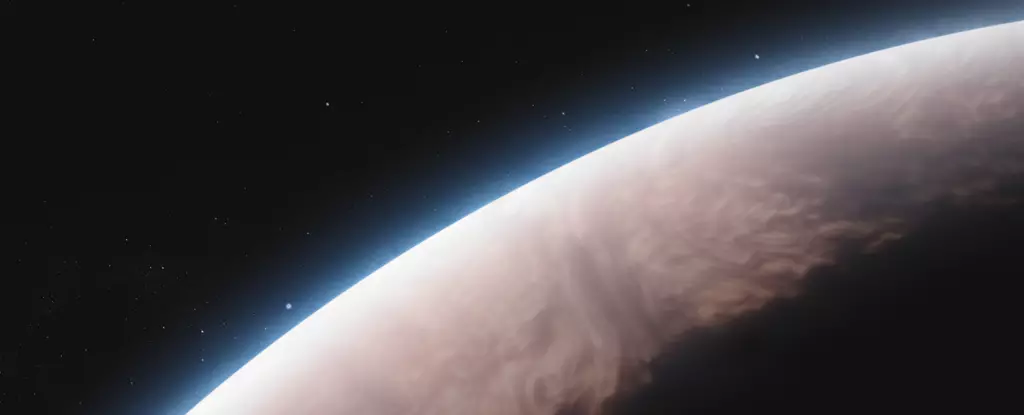In a groundbreaking study published in The Astrophysical Journal Letters, researchers have made an astonishing discovery using data obtained by the James Webb Space Telescope’s (JWST) Mid-Infrared Instrument (MIRI). They have identified the presence of quartz nanocrystals in the upper atmosphere of an exoplanet known as WASP-17 b. This exoplanet, located approximately 1,324 light-years from Earth, has a mass and radius that are about 0.78 and 1.87 times that of Jupiter, respectively. The surprising revelation of quartz nanocrystals in the atmosphere of WASP-17 b provides valuable insights into the formation and evolution of exoplanetary clouds and their respective atmospheres.
Traditionally, exoplanets have been found to possess magnesium-rich silicates such as pyroxene or olivine. However, the study conducted by the JWST’s MIRI has revealed that the atmosphere of WASP-17 b contains quartz crystals. This unexpected finding challenges previous understanding and opens up new avenues for research in exoplanetary science. The researchers were particularly fascinated by the fact that the size of these quartz crystals is only 10 nanometers in diameter, significantly smaller than the centimeter-sized quartz crystals found on Earth. This raises the question of how such tiny crystals can form in the extreme conditions of WASP-17 b’s atmosphere.
WASP-17 b is classified as a “puffy” hot Jupiter due to its short 3.7-day orbital period and scorching temperatures. The astronomers estimate that the temperature on WASP-17 b reaches a staggering 1,500 degrees Celsius (2,700°F). Additionally, the atmospheric pressure on the planet is only about one-thousandth of what we experience on Earth’s surface. In these extreme conditions, solid crystals can directly form from gas, bypassing the liquid phase. This unique process allows for the formation of quartz nanocrystals in WASP-17 b’s upper atmosphere.
Discovered in 2009, WASP-17 b is a remarkable exoplanet that exhibits a retrograde orbit, meaning it orbits in the opposite direction of its star’s rotation. Furthermore, previous studies have identified water and sodium in its atmosphere. With a mass smaller than that of Jupiter but a volume over seven times greater, WASP-17 b is considered one of the puffiest exoplanets discovered so far. Although quartz has been found in its atmosphere, the overall composition of the planet’s atmosphere is similar to traditional gas giant planets, consisting primarily of hydrogen and helium. WASP-17 b is also tidally locked with its parent star, ensuring that one side of the planet always faces the star.
The discovery of quartz nanocrystals in the atmosphere of WASP-17 b has significant implications for our understanding of exoplanetary atmospheres. The unique formation and characteristics of these crystals shed light on the complex processes occurring in hot Jupiters like WASP-17 b. Furthermore, studying the activity of the clouds and the quantity of quartz present in the atmosphere will provide valuable insights into atmospheric dynamics and the intricate interplay between clouds and atmospheric circulation.
The study was conducted as part of the Webb Guaranteed Time Observation (GTO) program, specifically the Deep Reconnaissance of Exoplanet Atmospheres using Multi-instrument Spectroscopy (DREAMS) investigation led by the JWST-Telescope Scientist Team. The primary goal of DREAMS is to conduct detailed analyses of exoplanets from different classes. WASP-17 b was selected as the representative hot Jupiter for this investigation. Future research endeavors will focus on uncovering further information about the formation and evolution of exoplanetary atmospheres, using the quartz nanocrystals found in the upper atmosphere of WASP-17 b as a foundation.
The discovery of quartz nanocrystals in the upper atmosphere of WASP-17 b has defied previous expectations and expanded our understanding of exoplanetary atmospheres. These tiny crystals, with their unique formation process and distinguishing characteristics, have the potential to revolutionize our knowledge of cloud formation and atmospheric dynamics in exoplanets. As scientists continue to explore these distant worlds, each revelation brings us closer to unraveling the mysteries of the universe and the countless wonders that lie beyond our Solar System.



Leave a Reply